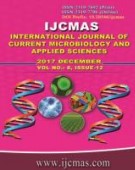


 National Academy of Agricultural Sciences (NAAS)
National Academy of Agricultural Sciences (NAAS)

|
PRINT ISSN : 2319-7692
Online ISSN : 2319-7706 Issues : 12 per year Publisher : Excellent Publishers Email : editorijcmas@gmail.com / submit@ijcmas.com Editor-in-chief: Dr.M.Prakash Index Copernicus ICV 2018: 95.39 NAAS RATING 2020: 5.38 |
The research study was carried out in Dharwad and Belgaum districts of North Karnataka during the year 2013-14. Following the simple random sampling, 120 respondents were selected from six villages of two taluks. The data was elicited through personal interview method. The important findings of the study were; majority of the respondents possessed medium level of knowledge (72.50%) and adoption (68.33%) about improved cultivation practices of mango. Almost all the mango grower had grown Alphonso and Totapuri varieties. More than half the number of mango growers had followed the recommended spacing, irrigation for young gardens and applied different chemicals for the control of the mango hopper and the powdery mildew disease. Majority (79.16%) of the respondents had followed manual harvesting by labours, cent per cent of the respondents stored the mangoes on the ground itself. Majority of the respondents (81.66%) had used truck for transportation. Only 20.00 and 15.00 per cent of the respondents followed the processing for juice and pickle making, respectively. Majority (59.17%) of the respondents belonged to the middle age group. A considerable percentage of respondents (23.33%) educated upto primary school. Further, they had medium level of management orientation, risk orientation, scientific orientation, extension contact, extension participation and mass media participation, respectively. Majority of the mango growers (64.17%) had small farms. Majority of the respondents (74.17%) possessed television sets, among them 55.83 per cent of farmers regularly viewed the news. Post-harvest losses at farm level were quantified, which accounted for about 8.44 per cent. Losses at wholesale market including transportation accounted for about 4.93 per cent. Losses at retailing market, losses at storage unit and losses at consumer level accounted for about 5.46, 3.19 and 6.82 per cent respectively. Overall post-harvest losses in mango at different stages from harvesting to consumption were quantified which accounted for about 34.49 per cent. Majority (78.00%) of the respondents expressed the problems such as lack of knowledge on the post-harvest technologies, lack of storage facilities even for few days (65.00%), problem of market transportation (62.00%) and lack of technical guidance about post-harvest technologies (46.66%).
 |
 |
 |
 |
 |